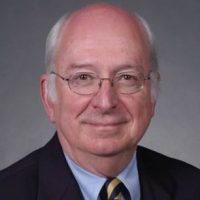
1987-89 ASMBS President
Most Important Event
Revision of the infrastructure of ASBS, including revision of the bylaws, the creation of working committees, and a plan for fiscal solvency.
When I was asked to join the faculty at the University of Florida after completing my training there, Dr. Edward R. Woodward, the chairman, needed a warm body to join the department because his associate of several years had decided to leave. The stipend, though small, was competitive. Woodward sweetened the offer by assigning me the job of writing a paper with Dr. Dragstedt, and, by the way, overseeing the fledgling program in bariatric surgery. The procedure that was being performed was a jejunoileal bypass. Intrigued by some of the metabolic sequelae that we were seeing and with the help of a dedicated nurse, clinician, and researcher (Margaret Duerson), we began to study these patients in some detail. In 1977, Woodward and I were contacted by Edward E. Mason to come to Iowa City for a “colloquium” of surgeons doing operations to control obesity; Woodward did not make the trip, but I did. Subsequently, we met each June, in Iowa, and the organization was formally established at the meeting in 1983. Mason being chosen as the first president for a two-year term. Infrastructure of the fledging organization was sketchy with Tom Blommers providing administrative support. Kathleen Renquist worked with Mason to establish a database of patients; first amongst Mason’s circle of close friends, then including a larger cohort of surgeons. The Florida group was included in the second tier.
The first several years of the ASMBS saw a diverse group of individuals participating. Subsequently, two camps began to materialize. First; there was a group of Antidotelists, who looked upon events as singular. The other camp, made up of a small number of young, clinically active, academic surgeons, sought to apply a modicum of scientific rigor to the meetings. Although affability reigned, there were always certain tensions between these groups. John Halverson, from Washington University, was particularly intent on applying the scientific method to all presentations. John was selected as the second president. He also served two terms as president, and it was under John’s leadership that the first meeting of the colloquium/American Society of Bariatric Surgery was held outside of Iowa City. The host city was St. Louis and the co-sponsor of the meeting was Washington University. I had the honor of being selected the third president, was the last of the two-term presidents, and brought the meeting in 1988 to Nashville, Tennessee. The meeting was co-sponsored by Vanderbilt University, and it was here, that Dr. H. William Scott delivered the first Mason Lecture.
The general tenor of the times was that obesity was the end result of gluttony and sloth, and the established surgical community tolerated those of us who had an interest in this condition (not, at that time, thought to be a disease), but just barely. The prejudice ran so deeply that virtually no papers on the subject were presented at national meetings, unless they were an exploitation of the complications that occurred postoperatively. Little credence was given to the results that were published, and most of the surgeons that were involved in the specialty were virtually ostracized from academic promotion and membership in certain societies. It is amazing to me, to reflect on those “hard times”, when compared with, and contrasted to, the current environment, where laparoscopic bariatric procedures represent the second most common intra-abdominal operation performed by today’s surgeons in the United States. It is remarkable to see the enormous advances that are now discussed and published in every venue.
In the first official meeting of the organization, there were probably sixty surgeons in the audience, with about half of those surgeons having their transportation paid to attend the event. The growth of the organization, especially in the past decade, has been exponential.
We have, in fact, come a long way, but there is still much to know and much to better understand.
Sincerely,
Patrick O’Leary, MD